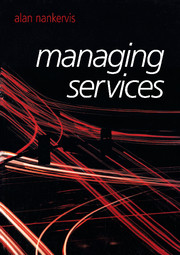Book contents
- Frontmatter
- Contents
- Figures and tables
- Contributors
- Preface
- Acknowledgements
- 1 Services and their management
- 2 The services environment
- 3 Stakeholders and their influence on services
- 4 Managing strategy in services
- 5 Marketing management in services
- 6 Strategic operations management in services
- 7 Financial management in services
- 8 Human resource management in services
- 9 From managing ‘service’ to integrated services management
- Index
- References
6 - Strategic operations management in services
Published online by Cambridge University Press: 22 September 2009
- Frontmatter
- Contents
- Figures and tables
- Contributors
- Preface
- Acknowledgements
- 1 Services and their management
- 2 The services environment
- 3 Stakeholders and their influence on services
- 4 Managing strategy in services
- 5 Marketing management in services
- 6 Strategic operations management in services
- 7 Financial management in services
- 8 Human resource management in services
- 9 From managing ‘service’ to integrated services management
- Index
- References
Summary
Learning objectives
After studying this chapter, readers will be able to:
discuss the nature, scope and significance of operations management within services
define the concept of operations management and explain its various functions and dimensions
explain a variety of operations management concepts and theories
discuss the main issues and challenges associated with managing the operations of services.
Introduction
The previous chapters have presented the nature and scope of the strategic management of services. The two interdependent, but discrete, domains of management – the corporate (or strategic) domain, and the functional (or operational) domain – are both needed for the management of organisational efficiency and effectiveness, and hence survival. The special vulnerability to external pressures and influences when managing services (as discussed in Chapters 2 and 3) makes strategic management especially important (as discussed in Chapters 4 and 5). However, the management of the service delivery process (a significant component of the service ‘product’) is of equal importance. This chapter will provide an overview of services operations management in a cross-functional management context. This integrated approach to the management of services will examine the issues and challenges significant for those dealing with operations management.
The functional management domain, as discussed in Chapter 1, presents the concept of management of an organisation's marketing, operations, finances, and human resources as being significant for organisations involved in services.
- Type
- Chapter
- Information
- Managing Services , pp. 203 - 251Publisher: Cambridge University PressPrint publication year: 2005



